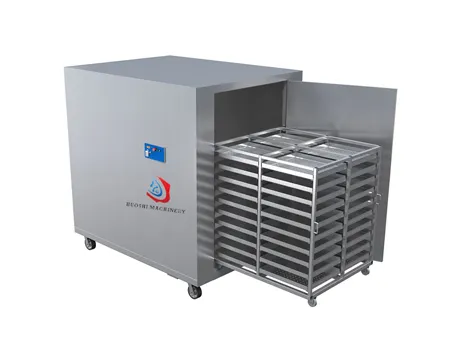In conventional procedures, tray dryers are used to achieve optimum drying results.
Wet granulation is the most common and most frequently used form of tablet manufacture. Its appeal stems from the fact that granulation is more likely to meet all the physical conditions for the pressing of quality tablets. The number of individual steps involved, and the time and work required to perform the procedure, especially on a large scale, are its main drawbacks. Weighing, mixing, wet weighing, sieving of wet blocks, drying, dry sieving, lubrication and compression are the steps in the wet process.
The equipment required depends on the batch size and the percentage of active ingredients in the total weight of the tablet.
Low Shear mixers/granulators,
High Shear mixers/granulators,
Fluid-Bed granulators/Tray dryers,
Spray Dryers, or
Extruders and Spheronizers.

Tray Dryer
Dryers are used to evaporate or sublimate liquids or moisture from bulk solids, powders, components, continuous sheets or other liquids. Direct dryers and indirect dryers are the two most common types. Direct dryers heat products by bringing them into direct contact with heated air, gas or burning gas products. Indirect dryers heat the product by conduction heating the product against a heated wall.
In the conventional process, a tray dryer is used to achieve optimum drying results. This is a two-door cabinet with a double-walled interior. To prevent heat transfer, the gap between the two walls is filled with high-density glass fibre wool insulation. The doors include gaskets. On the mobile trolley, stainless steel trays are placed. The tray dryer is equipped with a control panel, process timer, digital temperature controller and cum indication. Tray dryers are available in capacities of 6, 12, 24, 48, 96 and 192 trays.
A tray dryer is an enclosed insulated chamber with trays stacked together in a trolley. Tray dryers are used in industries where heating and drying is a key aspect of the manufacturing process, such as chemicals, dyes, pharmaceuticals, food and pigments. In the trays, the moist or solid material to be dried is placed.
The heat is transferred by the circulation of hot air generated by electric heaters or steam generated by radiator coils. The interior is equipped with a blower to ensure proper heat circulation and transfer. On the outside of the dryer is a control panel for controlling the temperature and other parameters. These dryers are available in a variety of materials, including mild steel, stainless steel and wood.
Pigments, foodstuffs, bread, electrodes, chemicals and plastic powders are all dried using tray dryers. Electrically heated, steam heated and thermal fluid heated drying ovens can often be used.
Electrically heated models include a computerised temperature controller with a digital timer to make working day and night easier. A digital temperature indicator and digital timer are included in the steam and thermal fluid heating models, but not in the temperature controller.
There is a very efficient circulating air system available. To maximise drying, warm air is recirculated with a specific amount of fresh air. The system is set up so that the material at the top and bottom is dried at the same time.
The oven’s assets include even air circulation, controlled temperatures, durable construction and spacious work surfaces. It is designed to cover a wide temperature range and is quick and easy to load and unload. The pallet trolley rolls in and out of the chamber with greater capacity. A spare trolley can be used for loading during drying cycle operation for continuous operation.
Hot air is continuously pumped into the tray dryer. To remove the moisture from the solids placed in the trays, forced convection heating is used.
At the same time, the wet air is partially exhausted.
The trays are loaded with wet solids. In the chamber, trays are set up.
Fresh air is conveyed through the inlet and is heated as it passes through the heater.
A fan circulates the heated air at a speed of 2 to 5 metres per second.
The turbulence reduces the thickness of the air boundary layer and lowers the partial pressure of the vapour in the atmosphere.